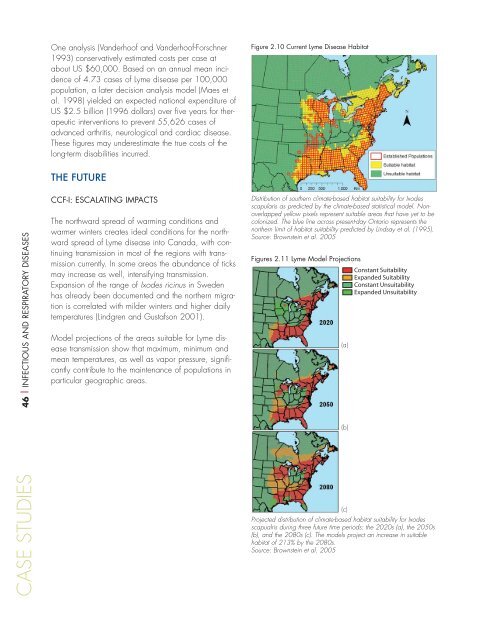Climate change futures: health, ecological and economic dimensions
Climate change futures: health, ecological and economic dimensions
Climate change futures: health, ecological and economic dimensions
You also want an ePaper? Increase the reach of your titles
YUMPU automatically turns print PDFs into web optimized ePapers that Google loves.
One analysis (V<strong>and</strong>erhoof <strong>and</strong> V<strong>and</strong>erhoof-Forschner<br />
1993) conservatively estimated costs per case at<br />
about US $60,000. Based on an annual mean incidence<br />
of 4.73 cases of Lyme disease per 100,000<br />
population, a later decision analysis model (Maes et<br />
al. 1998) yielded an expected national expenditure of<br />
US $2.5 billion (1996 dollars) over five years for therapeutic<br />
interventions to prevent 55,626 cases of<br />
advanced arthritis, neurological <strong>and</strong> cardiac disease.<br />
These figures may underestimate the true costs of the<br />
long-term disabilities incurred.<br />
Figure 2.10 Current Lyme Disease Habitat<br />
THE FUTURE<br />
46 | INFECTIOUS AND RESPIRATORY DISEASES<br />
CCF-I: ESCALATING IMPACTS<br />
The northward spread of warming conditions <strong>and</strong><br />
warmer winters creates ideal conditions for the northward<br />
spread of Lyme disease into Canada, with continuing<br />
transmission in most of the regions with transmission<br />
currently. In some areas the abundance of ticks<br />
may increase as well, intensifying transmission.<br />
Expansion of the range of Ixodes ricinus in Sweden<br />
has already been documented <strong>and</strong> the northern migration<br />
is correlated with milder winters <strong>and</strong> higher daily<br />
temperatures (Lindgren <strong>and</strong> Gustafson 2001).<br />
Model projections of the areas suitable for Lyme disease<br />
transmission show that maximum, minimum <strong>and</strong><br />
mean temperatures, as well as vapor pressure, significantly<br />
contribute to the maintenance of populations in<br />
particular geographic areas.<br />
Distribution of southern climate-based habitat suitability for Ixodes<br />
scapularis as predicted by the climate-based statistical model. Nonoverlapped<br />
yellow pixels represent suitable areas that have yet to be<br />
colonized. The blue line across present-day Ontario represents the<br />
northern limit of habitat suitability predicted by Lindsay et al. (1995).<br />
Source: Brownstein et al. 2005<br />
Figures 2.11 Lyme Model Projections<br />
(a)<br />
Constant Suitability<br />
Exp<strong>and</strong>ed Suitability<br />
Constant Unsuitability<br />
Exp<strong>and</strong>ed Unsuitability<br />
(b)<br />
CASE STUDIES<br />
(c)<br />
Projected distribution of climate-based habitat suitability for Ixodes<br />
scapualris during three future time periods: the 2020s (a), the 2050s<br />
(b), <strong>and</strong> the 2080s (c). The models project an increase in suitable<br />
habitat of 213% by the 2080s.<br />
Source: Brownstein et al. 2005

















